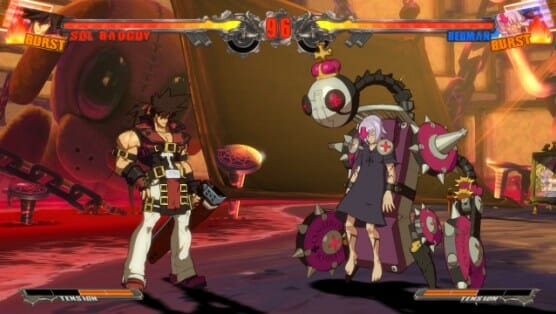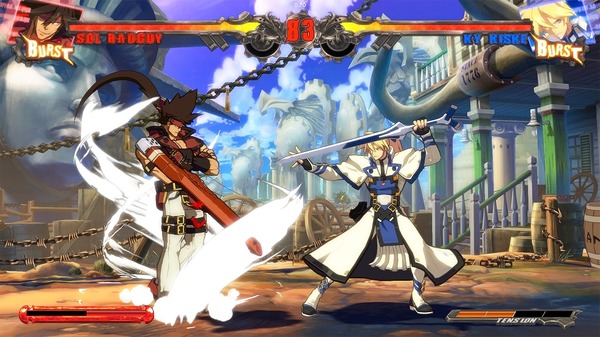Guilty Gear Xrd – SIGN: Sincerely Outrageous

The fighting game community calls it God’s Gift; gorgeously anime, ludicrously over the top, and lovingly designed, Guilty Gear Xrd – SIGN is extremely fucking metal and there’s still not any other game like it. Guilty Gear can easily be recommended to people who love fighting games, people who love stories that make less sense the more you read them, and people who love character designs that are sincerely outrageous. I love all of that, which is probably in part due to playing Guilty Gear X in 2003! Guilty Gear Xrd – SIGN is a new direction for the series—a restrained step back in the fighting design in the decade-long history of the meticulously iterated fighter, a massive step forward graphically not just for the series but computer animation in general, and a incomprehensible warp in all possible directions for its endearingly messy story.
The metal aesthetic is strong in Guilty Gear Xrd – SIGN—all of the tracks were composed by the series writer and character designer Daisuke Ishiwatari, who loves metal very much and is clearly having a good time. Nearly every character is named after a metal or classic rock band or singer and in an industry which mostly has character designs that are “bald and angry” or “anime and sad” Guilty Gear consistently produces the absolute wildest and absurd characters with genuine enthusiasm, from the relatively normal characters like Chipp Zanuff, white guy ninja whose ambition is to become president, and May, a small girl who wields an anchor as big as her and shoots dolphins at people, to the truly bizarre like Faust, a nine foot tall doctor with a bag over his head that fights with a giant scalpel. Guilty Gear Xrd – SIGN introduces Bedman, a sleeping boy strapped to giant evil mechanical bed, and Elphelt Valentine, who fights in a wedding dress and alternates between attacking with her bouquet and her pink and ribbon covered collection of grenades and firearms, so I am very happy to report that Guilty Gear has not lost its sincerity.
I am extremely attached to Guilty Gear’s story, as it is the kind of incredible story that makes less sense the more you know about it. I actually think this rules though; I kind of hate video games when they take themselves too seriously, and okay, Guilty Gear does take itself seriously but it is also having SO much fun that you can’t really get mad about it. Mysterious clone soldier Ramlethal Valentine from the magical dimension known as the Backyard appears above the ruins of Japan and declares war on the world! The UN conspires with her in a sinister plot to enslave mankind! A bounty hunter named Sol Badguy stops her with her sister Elphelt Valentine and she learns how to experience human emotions with the help of a magical puppy! A boy in a giant bed named Bedman teleports around being a huge jerk to everyone! This is awesome and I don’t know why!
It helps that Guilty Gear Xrd – SIGN is incredibly beautiful. The story mode doesn’t actually feature any interactivity at all, but it’s about half visual novel with voice and animation and half anime, and given the structure of other fight games stories I’d much rather just watch this. It’s difficult to overstate how good Guilty Gear Xrd – SIGN looks, how close it resembles hand drawn animation. That is due to combination of the structure provided by the Unreal Engine and the fact that the animators of Guilty Gear Xrd – SIGN drew all of the character animations by hand, even little things like the clouds of dust when they jump and run! You can read some translations of how this process worked here but the level of attention to detail here is incredible, and helps to explain why games with cel shading like Marvel Vs. Capcom 3 may have a 2D aesthetic but they still don’t quite have the feel of hand drawn animation. A game that looks and feels better than any other 2D fighter and that can show off by spinning the camera to show that they’re really 3D models is an amazing accomplishment.
As much as I love the aesthetics of Guilty Gear, it’s also a very, very good fighting game, as unique in that as everything else. During the period of time between Street Fighter 3 and Street Fighter 4, Guilty Gear was one of the biggest fighters still being produced, and during its lifetime from Guilty Gear X in 2000 to Guilty Gear XX Accent Core Plus R in 2012 (this space reserved for you to react to that subtitle) the game had gone through seven major revisions, which is a somewhat ridiculous number for an arcade and console series in the era before updating and revising competitive games over the internet was standard. That is unique in and of itself, but Arc System Work’s approach to revising the characters was also fairly exceptional—rather than necessarily fix unintended strategies or overpowered moves, they would actually start designing and balancing characters around those powerful emergent qualities. In other words, rather than fixing overpowered characters to function as originally intended, they tried to let players play them the way they enjoyed and balance their power in other ways.
The result is a cast that was honed into fascinating directions over a literal decade. The character designs are wild, but the way they fight is an intricate and very complex interaction of their specific skill sets, giving them a depth of character that’s very in keeping with their unique designs. Millia Rage is the fastest character in the game, but she possesses only very specific situational attacks and some of the lowest health in the game. She has several super strong projectiles, but they have such long startup times she’ll be easily hit before they go off. Why is she like this? It turns out that her incredible speed and situational attacks are so she can patiently keep distance while aggressively and quickly punishing openings, and her projectiles are so slow to start up because she’s supposed to use them when her opponents are knocked down, so that when they activate they will keep them pinned down and allow her to continue doing so until they fail to block and she scores another knockdown. This sounds super complicated and absolutely, totally is. Watching a good Millia player is absolutely breathtaking and totally out of my league, much like her!
